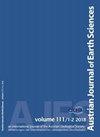Jurassic–Cretaceous radiolarian-bearing strata from the Gresten Klippen Zone and the St. Veit Klippen Zone (Wienerwald, Eastern Alps, Austria): Implications for stratigraphy and paleogeography
IF 1.1
4区 地球科学
Q2 Earth and Planetary Sciences
引用次数: 4
Abstract
Abstract Two sections of the klippen zones in the Wienerwald area have been investigated for their stratigraphy: (1) The Gern section of the Main Klippen Zone, a part of the Gresten Klippen Zone, and (2) the St. Veit Klippen Zone in the Lainz Tunnel and the neighboring outcrops in western Vienna. New biostratigraphic data are based on radiolaria from siliceous intervals and a few findings of calcareous nannofossils from marlstones. In the Gresten Klippen Zone, radiolarian assemblages from limestones of the Gern locality indicate a middle Oxfordian to early Kimmeridgian age of the Scheibbsbach Formation. Radiolarian and nannofossil data from the St. Veit Klippen Zone in the Lainz railway tunnel locality, as well as correlated outcrops from the Lainzer Tiergarten and the Gemeindeberg in the southwest of Vienna, indicate the presence of mainly Bajocian to lower Oxfordian red radiolarites and cherts (Rotenberg Formation). Siliceous, grey limestones and cherts of the Fasselgraben Formation range from the upper Oxfordian–Kimmeridgian to the Valanginian–Barremian. The Main Klippen Zone was derived from the European margin to the north, and this zone is regarded as a Helvetic paleogeographic unit. The St. Veit Klippen Zone in the Lainz Tunnel section contains no ophiolitic material and shows a tectonic contact with the surrounding Rhenodanubian nappe system, which indicates no primary sedimentary contact of the St. Veit Klippen Zone with the Flysch units, as well as demonstrating the presence of two structurally separated Alpine tectonic units. Thus, a direct correlation with the Ybbsitz Zone is not supported, and an original paleogeographic position in the transition from the Penninic Ocean to the Austroalpine continental fragment is proposed.Gresten-Klippen带和St.Veit-Klippen带(奥地利东阿尔卑斯省Wienerwald)的侏罗纪-白垩纪放射虫地层:对地层学和古地理的影响
摘要对Wienerwald地区的klippen带的两个剖面进行了地层学调查:(1)Gresten-klippen带的一部分Main klippen区的Gern剖面,以及(2)Lainz隧道中的St.Veit klippen地带和维也纳西部邻近的露头。新的生物地层学数据基于硅质层段的放射虫和泥灰岩中的一些钙质超微化石。在Gresten-Klippen带,Gern地区石灰岩的放射虫组合表明Scheibbsbach组为牛津中期至Kimmeridian早期。Lainz铁路隧道区St.Veit-Klippen带的放射虫和超微化石数据,以及维也纳西南部Lainzer-Tiergarten和Gemeindberg的相关露头,表明主要存在Bajocian至lower Oxfordian红色放射虫和燧石(Rotenberg组)。Fasselgraben组的硅质、灰色石灰岩和燧石分布在上牛津阶-基梅里阶至瓦朗吉阶-巴雷阶。克利本主带起源于北部的欧洲边缘,该带被视为海尔维纪古地理单元。Lainz隧道段的St.Veit-Klippen带不含蛇绿质物质,显示出与周围Rhenodanubian推覆体系统的构造接触,这表明St.Veit Klippen区与Flysch单元没有主要沉积接触,并表明存在两个结构分离的阿尔卑斯构造单元。因此,不支持与Ybbsitz带的直接相关性,并提出了从宾夕法尼亚洋到奥阿尔卑斯大陆碎片过渡的原始古地理位置。
本文章由计算机程序翻译,如有差异,请以英文原文为准。
求助全文
约1分钟内获得全文
求助全文
来源期刊

Austrian Journal of Earth Sciences
Earth and Planetary Sciences-Paleontology
CiteScore
3.10
自引率
0.00%
发文量
0
审稿时长
>12 weeks
期刊介绍:
AUSTRIAN JOURNAL OF EARTH SCIENCES is the official journal of the Austrian Geological, Mineralogical and Palaeontological Societies, hosted by a country that is famous for its spectacular mountains that are the birthplace for many geological and mineralogical concepts in modern Earth science.
AUSTRIAN JOURNAL OF EARTH SCIENCE focuses on all aspects relevant to the geosciences of the Alps, Bohemian Massif and surrounding areas. Contributions on other regions are welcome if they embed their findings into a conceptual framework that relates the contribution to Alpine-type orogens and Alpine regions in general, and are thus relevant to an international audience. Contributions are subject to peer review and editorial control according to SCI guidelines to ensure that the required standard of scientific excellence is maintained.
 求助内容:
求助内容: 应助结果提醒方式:
应助结果提醒方式:


